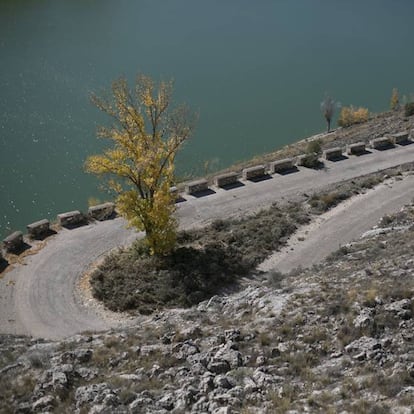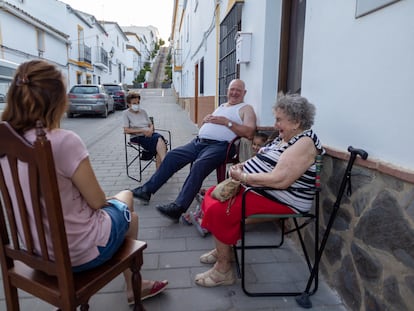The drowning of Spain’s villages
A handful of books are recreating the cruel and little-known history of the communities that were flooded to make reservoirs in the 20th century
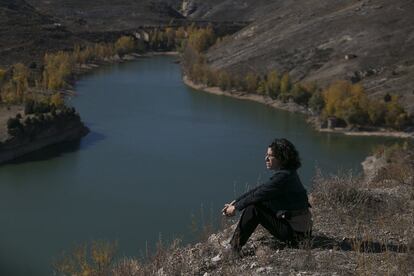
A road snakes down to the foot of a man-made lake. It’s overlooked by Peña del Reloj mountain, whose shadow clocks the passing of the hours as it presides over a silent liquid landscape. The only thing to suggest that the lake is not natural is a circular construction crowned with greenery where the bell of a Romanic church once tolled. Crushed by thousands of tons of water, the centuries-old village of Linares del Arroyo lies beneath the surface. Its origins date back to the 10th century but in the 1950s it was submerged under a colossal dam that formed part of the reservoir of Riaza River.
Five hundred villages across Spain were similarly devastated in the name of progress during the second half of the 20th century. In the depths of the Linares reservoir lie the skeletons of humble dwellings, as well as the belongings and the graves of the loved ones of those who once made their home in this corner of Segovia, in Spain’s Castilla y León region, now populated by vultures.
Montserrat Iglesias, a high school teacher and a descendant of the town’s last inhabitants, has recounted the stories she heard throughout her childhood and youth in her book La Marca de Agua (or, The Water Mark). In the novel, Iglesias seeks to “give voice” to the villagers – more than 200 in Linares and 50,000 in the whole of Spain – who were not only forced to relocate and lose their way of life but to forfeit any trace of it. The book depicts the journey her ancestors made from Linares to La Vid in Burgos, 20 kilometers away. La Vid was one of the 300 villages of identical white houses that the Francisco Franco regime constructed to house the exiles of the flooded land.
With one foot in their new home but their hearts in the old one, they worked the land assigned to them. As Iglesias says, despite their circumstances, they were labeled intruders. Basically, they had lost their place on Earth.
Iglesias is not the first author to write about submerged Spain, although there are only a handful of books that deal with it from the literary point of view. Novelist and civil engineer Juan Benet wrote the legendary Volverás a Región (or, Return to Region) while he was working on the Porma reservoir; Ana María Matute penned El Rió (or, The River); while Jesús Moncada wrote Mequinenza and Julio Llamazares authored Distintas Formas de Mirar el Agua (or, A Different Way to View Water).
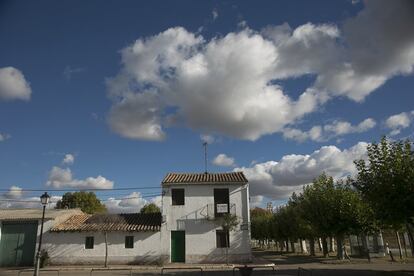
Llamazares, who was born in the village of Vegamián in Castilla y Léon – an area drowned by Benet’s reservoir – called his book “the novel of his life,” a return to the origins of Spain that, like Iglesias’ novel, examines the themes of family and death, but also the uprooting of lives, identity and oblivion. “The history of the reservoir is in itself buried,” he says. “During Franco’s regime, the inauguration of the reservoir was highly publicized, but not the human drama behind it.”
The pain of the Spanish Civil War and the agony of the postwar period still survive in the depths of those reservoirs that multiplied during the dictatorship, although they had been conceived of decades earlier. The pain, betrayal and submission are captured in The Water Mark, which brings to life the seven dead who still lie in a lost grave in Linares. Similar themes appear in the book, Detendrán Mi Río (or, They Will Stop My River) by Virginia Mendoza. This novel, to be published on November 15, is about the village of Caspe, in Zaragoza province, and a nearby orchard called Cauvaca, which was flooded by the Mequinenza reservoir.
We should be aware that basic things like taking a shower or turning on the light are due to the sacrifice of people who are not countedAuthor Virginia Mendoza
In addition to the 500 villages that were submerged, there is an undetermined number of inhabited orchards that perished too and which, as Mendoza points out, are not included when it comes to calculating the number of victims. “We should be aware that basic things like taking a shower or turning on the light are due to the sacrifice of people who are not counted,” says Mendoza, whose story is based on interviews with survivors from that period.
The full economic, social, geographical and anthropological implications of what happened with the construction of the reservoirs in Spain may not have resonated with most of society but in the towns where the locals were resettled, there is usually “at least one person,” according to Mendoza, who has dedicated themselves to collecting testimonies, photos and accounts.
Iglesias, meanwhile, speaks of the “mythification” of those places, transformed by oral tradition into dreamlike spaces that only exist in the imagination of men and women who have never stopped longing for them. “The fact of not being able to return creates that myth, and nostalgia magnifies the place,” says Iglesias, whose fiction has drawn on anecdotes and real names. “With the move, some won and others lost,” she says. “And there were also those who decided to forget.”
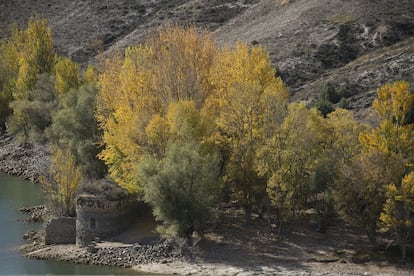
While wanting to bury this chapter of history in a country “that has always had a very bad relationship with its past,” probably accounts for the fact this piece of history has been forgotten, as Llamazares points out, the truth is that more recent events such as the construction of the Riaño reservoir in Castilla y León in 1987 and the Lindoso dam in Portugal in 1992, documented in the 2015 film The Drowned Days, did not make headlines in the press either. “There were big protests and two people committed suicide in Riaño,” recalls Llamazares. “But the item did not appear until the end of the news.”
As Mendoza writes, the fate of those places was sealed with concrete: the one used for both the reservoirs and the towns the locals were moved to; but also the one that covered the cemeteries to prevent the dead from surfacing. “For people to leave the dead behind with the knowledge that they would not be buried with their parents was a sorrow that weighed heavily on them,” she says.
Tu suscripción se está usando en otro dispositivo
¿Quieres añadir otro usuario a tu suscripción?
Si continúas leyendo en este dispositivo, no se podrá leer en el otro.
FlechaTu suscripción se está usando en otro dispositivo y solo puedes acceder a EL PAÍS desde un dispositivo a la vez.
Si quieres compartir tu cuenta, cambia tu suscripción a la modalidad Premium, así podrás añadir otro usuario. Cada uno accederá con su propia cuenta de email, lo que os permitirá personalizar vuestra experiencia en EL PAÍS.
¿Tienes una suscripción de empresa? Accede aquí para contratar más cuentas.
En el caso de no saber quién está usando tu cuenta, te recomendamos cambiar tu contraseña aquí.
Si decides continuar compartiendo tu cuenta, este mensaje se mostrará en tu dispositivo y en el de la otra persona que está usando tu cuenta de forma indefinida, afectando a tu experiencia de lectura. Puedes consultar aquí los términos y condiciones de la suscripción digital.
More information
Últimas noticias
Most viewed
- Reinhard Genzel, Nobel laureate in physics: ‘One-minute videos will never give you the truth’
- Oona Chaplin: ‘I told James Cameron that I was living in a treehouse and starting a permaculture project with a friend’
- Pablo Escobar’s hippos: A serious environmental problem, 40 years on
- Charles Dubouloz, mountaineering star, retires at 36 with a farewell tour inspired by Walter Bonatti
- Why we lost the habit of sleeping in two segments and how that changed our sense of time

